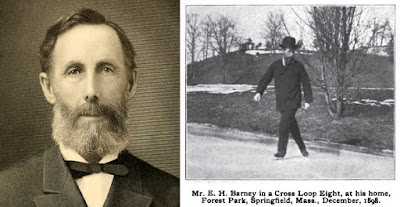 |
| Pecousic Villa (left)/ Carriage House [click image to enlarge] |
In the heart of Springfield, Massachusetts lies Forest Park, a sprawling 735-acre urban oasis offering residents and visitors alike a retreat from the city's hustle and bustle. While today it stands as one of the largest city parks in New England, its creation and expansion came at a significant cost, most notably the disappearance of a historic gem, the Pecousic Villa, also known as the Barney Mansion. This blog post delves into the history of the villa, its integral role in the creation of Forest Park, and the series of events leading to its unfortunate demolition.
The Birth of Pecousic Villa
Pecousic Villa was the elegant home of Everett Hosmer Barney, a prominent industrialist known for his invention and manufacture of the clamp-on ice skate. Constructed in the late 19th century, this grand mansion was nestled on the bluffs overlooking the Connecticut River in Springfield. The villa not only served as Barney's residence but also as a symbol of his success and contributions to the city's industrial growth.
 |
| Everett Hosmer Barney 1835 - 1916 |
The Creation of Forest Park
The story of Forest Park begins with Everett Hosmer Barney's visionary act in 1884. Recognizing the need for public green space in Springfield, Barney generously donated approximately 178 acres of his land, including the grounds surrounding Pecousic Villa, to the city. This donation laid the foundation for what would become Forest Park. Over the years, the park expanded through additional land acquisitions, growing to its current size and offering an array of recreational and cultural amenities, from hiking trails and sports facilities to the Forest Park Zoo.
 |
| Barney Hill Overlooking Connecticut River [click image to enlarge] |
Redrawing Boundaries for Progress
The expansion of Forest Park necessitated the redrawing of boundaries between Springfield and its neighboring town of Longmeadow. This change that took place in June 1890, primarily for additional acreage for the park, underscored the city's commitment to creating a substantial public green space. The adjustment of boundaries was a significant administrative move, reflecting the lengths to which the city was willing to go to ensure the park's growth and accessibility to the community. This was the first time that the Springfield/ Longmeadow boundary was changed followed by another change in June 1914.
 |
| Longmeadow/ Springfield Boundary Changes |
The Impact of Interstate 91
The construction of Interstate 91 in the 1960s marked a pivotal moment for Springfield and, tragically, for Pecousic Villa itself. The new highway was part of a broader trend of urban development during the era, which often prioritized transportation infrastructure over historical preservation. Its construction led to the demolition of the Barney Mansion in 1959, erasing a piece of Springfield's history to make way for progress and connectivity. The loss of Pecousic Villa to the interstate project is a stark reminder of the costs associated with urban development, especially when it comes at the expense of preserving historical landmarks.
 | |
| Pecousic Villa being demolished Photo courtesy of Paul Meagher/ Robert Goff/ Rob Brogle |
 |
| Approximate Location of Pecousic Villa [click image to enlarge] |
Reflections on the Legacy of Pecousic Villa
The disappearance of Pecousic Villa is a poignant chapter in Springfield's history, embodying the complex interplay between progress and preservation. While Forest Park remains a cherished green space, serving as a testament to Barney's legacy and philanthropy, the absence of the Barney Mansion leaves a void in the historical tapestry of the city. It serves as a reminder of what is lost when the wheels of progress roll forward without due consideration for the past.
As Springfield continues to evolve, the story of Pecousic Villa and the creation of Forest Park offers valuable lessons on the importance of balancing development with historical preservation. It challenges future generations to remember and honor the past, even as they forge ahead to build new legacies. The story of Everett Hosmer Barney, his mansion, and the park that grew from his generosity continues to inspire a vision of community, green space, and the delicate balance between preserving history and making way for the future.
________________________________
Written by Jim Moran/ Guest Historian
A special thank you to Paul Meagher- Springfield Ma- Historic Crossroad of New England for some of the photos used in this article.



No comments:
Post a Comment